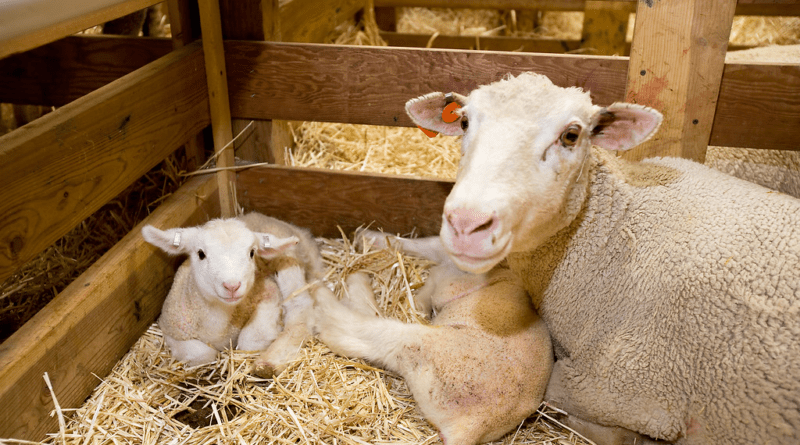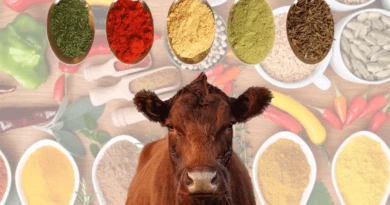How Often to Clean a Ruminant Pen
How often should the ruminant pen be cleaned? This is a question of hygiene which is very paramount to the health and general welfare of the animals. It is necessary that housing is swept and the dungs packed daily.
However, washing the housing units with soap and water should be done occasionally depending on the type of housing constructed for them. Washing the housing units once a week is not a bad option as this will help improve the general well-being of the animals.
Read Also: Ruminants Grazing Techniques – Suitable Methods
10 Cleaning and Disinfection Tips on a Ruminant Pen

The ruminant pen cleaning and disinfection tips in this section are recommended for equipment, traffic around barns, facilities, ruminant animals feed storage, water troughs, ruminant animal pens and farm employees.
1. Ruminant Farm Traffic and Animal Transport
- Keep visitor and service vehicles from driving over feed delivery or manure handling routes.
- Keep visiting vehicles out of areas accessible to livestock.
- Locate holding pens for animal pickups near the road and away from the barns or livestock areas.
- Use only clean, well-bedded trucks to move livestock to avoid introducing diseases and to avoid injuries during transport.
- Thoroughly wash and disinfect the inside, outside, and tires of livestock-hauling trucks or other implements of husbandry shared with neighbors.
2. Ruminant Pen Facilities Maintenance
- Replace fly tape, if necessary.
- Be aware of hiding and denning places for rodents. Set baits or traps accordingly. Use caution if dogs access the same area.
- Inspect and repair holes in buildings to prevent rodents from living there.
- Remove piles of boards, wood, or other junk.
- Check for rain and storm water damage.
- Identify and correct manure runoff problems.
- Remove standing water, which can be a breeding ground for mosquitoes.
- Prevent standing water on the ground near water systems in pastures.
- Check fences along farm and pasture perimeters; repair any damage
- Use electric fence wherever possible, if appropriate.
- Make changes to bird detractors and fly tape or other control methods as needed.
- Replace bird netting where needed and change bird detractors so that birds do not ignore their presence.
3. Ruminant Animals Feed Storage and Bunk Management
- Use optimal procedures for harvesting, handling, and storage of all crops.
- Make sure that feed bunks and storage areas are inaccessible to rodents, birds, dogs, cats, and other wildlife.
- Check for and dispose of moldy or spoiled material in silos, bunks, and bins. Upright silos need to be emptied to thoroughly clean.
- Bags of feed or feed ingredients should be stored off the floor (e.g. on pallets).
- Opened bags should be placed in or emptied into barrels with tight lids.
- Use steel feed bins rather than open-front commodity shed bays to reduce shrinkage (i.e., loss to wind, rodents, or birds) and prevent contamination.
- Clean in and around storage areas between batches of feed.
- Rotate inventory to limit the amount of pathogens in stored feeds.
- Keep covers on barrels and bins; make sure water is not getting into storage areas.
- Address any moisture problems periodically. Ensure that the storage environment is appropriate for feed.
- Protect all feeding areas from animal carcasses and manure.
- Follow optimal feed management practices.
- Use smooth feeding bunks to minimize the surface area that could be colonized by pathogens. Dispose of feed refusals if not eaten within 24 hours. Do not feed refusals from adult animals to young stock.
4. Ruminant Animals Water Quality and Trough Management
- Clean water troughs, buckets, or cups daily or weekly. Replace with ones that are easier to clean if this is a bottleneck.
- Disinfect waterers at least twice a year.
- Protect all water sources from animal carcasses and manure.
- Make sure a regular cleaning schedule of water troughs and tanks is being followed.
5. Equipment
- Clean and disinfect any equipment used on sick animals prior to use on healthy herd mates.
- Clean and disinfect dehorners, hoof knives, and clippers between animals.
- Use your own halters and clippers rather than borrowing them.
- Sanitize nursing bottles and buckets after each feeding.
Read Also: Importance of a Sick Bay in a Ruminant House
6. Ruminant Pen/Hutch Use and Disinfection
- Use maternity pens only for birthing animals.
- Move pregnant animals to clean pastures or paddocks prior to birthing.
- Use sick pens only for sick animals.
- Segregate sick animals and prevent animal-to-animal contact between sick pens and maternity pens.
- Provide a clean environment for birthing. For cattle, this is important to prevent the spread of Johne’s disease and salmonella, calf scours, and fresh cow mastitis.
- Clean all manure from the pens after use.
- Disinfect the walls and floors after use.
- Bed the pens before the next animal enters.
7. Ruminant Pen/Hutch Disinfection
- Remove all bedding.
- Remove sidewalls, gates, hog wire, if applicable.
- Power wash or steam clean all wood, metal, or concrete surfaces.
- Note: ammonia compounds should not be mixed with chlorine. The combination releases a harmful gas; acid compounds mixed with chlorine release toxic chlorine gas.
- The hot water or steam will inactivate most pathogens.
- Protect yourself from aerosolized material; wear goggles and a respirator.
- Rinse with a chlorine solution for additional sanitization.
- If a high-temperature pressure washer is not available, scrub all surfaces with detergent, rinse, and rinse again with a chlorine solution.
- Let dry before bedding for next use.
8. Employee Sanitation
- Provide on-farm laundry facilities for employees.
- Wash farm clothing with detergents and bleach or washing soda.
- Insist workers wash their hands before milking dairy animals and after working with sick animals.
- Nitrile gloves are recommended when frequent cleaning between animals is necessary.
- Insist workers wear protective plastic or rubber gloves when assisting with births.
9. Personal Protective Equipment
In preparation for crossing the clean/dirty line, prevent disease exposure from contaminated street clothes.
- Leave street clothes on dirty side, or cover with clean outerwear.
- Use disposable gloves and boots, and reusable boots. Employees may need a change of clothes.
- If possible, provide laundry facilities for employee outerwear on the “dirty side” of the line of separation.
In the case of a disease outbreak, or when personnel are cleaning and disinfecting, personal protective equipment (PPE) is the standard. In general, PPE is intended as a barrier to protect the user from hazards, such as biological and chemical agents, loud noises, and trauma.
PPE items include impermeable outer clothing, respirators, ear plugs, and hard hats. In livestock disease events, PPE as outer clothing, along with the proper protocols, is also used to prevent the transmission/spread of pathogens via contaminated clothing.
Disposable coveralls (e.g., Tyvek®), aprons, gloves, and boots, when properly utilized, prevent clothing from acting as a fomite (transfer of a disease agent by contact with an inanimate object such as clothing). In an animal health emergency, disposable PPE is preferred, as opposed to outer clothing that needs laundering.
Read Also: Stocking Management for Ruminant Animals
10. Boot Cleaning and Disinfection
Farms provide foot baths with the goal of preventing the transfer of pathogens among groups of animals. However, boot bath maintenance in many facilities can be poorly maintained, which leads to facility contamination by organic matter (manure, feed, etc.).
People commonly avoid stepping into boot baths or simply step through the bath without stopping to clean their boots. The most important thing to do is remove mud and manure from boots.
Disposable boots work well if protection is only needed for brief periods of time. Boot baths should be refilled at least every 2-3 days. For best results, it should be replaced daily.
Replacement of the disinfectant solution will also depend on the degree of traffic flow; more frequent replacement will be needed in large or busy areas or when organic debris accumulates in the boot bath. Phenolic compounds are most commonly used for boot baths, due to their effectiveness in the presence of organic matter.
Boot bath solutions should be kept from freezing, and protected from rain to avoid over-dilution. Rubber boots may be a better choice for footwear, because they can be soaked for as long as the disinfectant requires.
Supplies for a boot bath are simple and inexpensive:
- A scraper to clean off dried on manure, mud, etc.
- A plastic or metal tub with high sides that is large enough to step in with boots on.
- One or two good quality, long-handled scrub brush.
- Water hose
Use the following practices to minimize tracking disease agents into areas closely associated with livestock:
- Use a scraper or other utensil to clean visible dirt off boots before disinfecting.
- Use water and a scrub brush over a well-drained area. A boot cleaning station in which a hose is hooked up to a brush is a good option.
- Two tubs can be used. One that contains detergent to rinse boots after scraping off dry debris, and a second tub that contains the disinfectant solution.
- Prepare the disinfecting solution according to the label’s dilution measurements.
- Select disinfectants based on on-farm efficacy, cost, ease of use and environmental friendliness.
- Step in to the tub with boots on (or remove boots and place in the tub) and use a clean brush to scrub boots with the disinfectant solution.
- Soak boots in a clean disinfectant solution for the recommended time on label.
Read Also: The Impact of Inefficient Waste Management on Oceans









